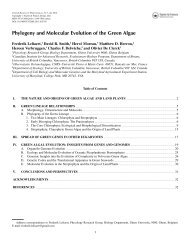The red algal genus Reticulocaulis from the Arabian
The red algal genus Reticulocaulis from the Arabian
The red algal genus Reticulocaulis from the Arabian
Create successful ePaper yourself
Turn your PDF publications into a flip-book with our unique Google optimized e-Paper software.
54 Phycologia, Vol. 42 (1), 2003<br />
Table 2. Comparison of morphological and anatomical characteristics among <strong>the</strong> genera of <strong>the</strong> Naccariaceae (Zerlang 1889; Kylin 1928; Kylin<br />
1956; Fan 1961; Womersley & Abbott 1968; Dixon & Irvine 1977; Abbott 1985; Hommersand & F<strong>red</strong>ericq 1990; Millar 1990; Womersley<br />
1996; Abbott 1999; this article).<br />
Feature Atractophora Naccaria <strong>Reticulocaulis</strong><br />
Branching pattern of determinate<br />
branches<br />
whorls of four periaxial cells per<br />
axial cell<br />
two periaxial cells per axial cell;<br />
branching on an irregular spiral<br />
of 1/4<br />
two periaxial cells per axial cell;<br />
branching on an irregular spiral<br />
of 1/4<br />
Sheath of inflated cells around absent present present<br />
axial strand<br />
Secondary pit connections absent present between jacket cells present between jacket cells<br />
Adventitious and rhizoidal filaments<br />
present present present<br />
Hairs on terminal cortical filament<br />
present present or absent present or absent<br />
cells<br />
Gametophytes monoecious monoecious or dioecious monoecious or dioecious<br />
Carpogonial branch (including three- to four-celled two- to eight-celled seven- to thirteen-celled<br />
carpogonium)<br />
Laterals on carpogonial branch<br />
cells<br />
short short primary laterals lengthy, secondary<br />
sterile filaments present<br />
Nutritive cells present absent or restricted to <strong>the</strong> hypogynous<br />
cell<br />
Immediate post-fertilization<br />
events<br />
Gonimoblast composition<br />
Localized swelling of <strong>the</strong> branches<br />
by mature cystocarps<br />
Position of spermatangial mo<strong>the</strong>r<br />
cells<br />
fusion of carpogonium with supporting<br />
cell by a short process<br />
fusion of carpogonium with hypogynous<br />
cell by widening of<br />
pit connection<br />
diffuse gonimoblast intermixed<br />
with vegetative filaments<br />
always present on <strong>the</strong> hypogynous<br />
cell, small clusters on<br />
<strong>the</strong> carpogonial branch cells<br />
#3, #4<br />
fusion of carpogonium with hypogynous<br />
cell by widening of<br />
pit connection<br />
diffuse gonimoblast intermixed<br />
compact gonimoblast lacking<br />
with vegetative filaments<br />
vegetative filaments<br />
present present absent<br />
? dendroid distal clusters or in catenate<br />
series<br />
dendroid distal clusters or in catenate<br />
series<br />
surround <strong>the</strong>ir central-axial filaments with a jacket of uninflated<br />
cells, have three- to four-celled recurved carpogonial<br />
branches bearing more than two sterile groups and produce a<br />
carposporophyte that surrounds <strong>the</strong> axial strand and intermingles<br />
with vegetative filaments. Liagorothamnion may thus<br />
prove to have a closer alliance with <strong>the</strong> Naccariaceae than<br />
with <strong>the</strong> Ceramiaceae.<br />
Abbott (1985) has suggested that <strong>Reticulocaulis</strong> ‘might be<br />
looked upon as <strong>red</strong>uced <strong>from</strong> Acrosymphyton-like forms in<br />
terms of <strong>the</strong> carpogonial branch . . .’ and hence related to <strong>the</strong><br />
Dumontiaceae, a family <strong>the</strong>n placed in <strong>the</strong> order Cryptonemiales<br />
and now a member of <strong>the</strong> Gigartinales (Saunders &<br />
Kraft 1997). <strong>The</strong> proposed affinity between <strong>Reticulocaulis</strong> and<br />
Acrosymphyton is not supported by recent evidence. According<br />
to a phylogenetic analysis of <strong>the</strong> Dumontiaceae (Tai et al.<br />
2001), Acrosymphyton (Acrosymphytaceae; Lindstrom 1987)<br />
is sister to <strong>the</strong> Gelidiales, whereas Bonnemaisonia is basal to<br />
<strong>the</strong> included Gigartinales and Gelidiales. Ongoing molecular<br />
research (G.W. Saunders & C.A. Maggs, personal communication)<br />
shows that <strong>the</strong> Naccariaceae is almost certainly not<br />
monophyletic (Naccaria groups weakly with <strong>the</strong> Bonnemaisoniaceae<br />
and may not belong in <strong>the</strong> Bonnemaisoniales,<br />
whereas Atractophora receives solid support as a member of<br />
<strong>the</strong> Bonnemaisoniaceae), and it clearly does not belong in ei<strong>the</strong>r<br />
<strong>the</strong> Nemaliales or <strong>the</strong> Gigartinales. Saunders & Kraft<br />
(1997, p. 130) suggested that DNA studies of <strong>the</strong> Naccariaceae,<br />
to establish its ordinal affinities, should be a top priority<br />
for molecular systematists, and this recommendation still<br />
holds.<br />
ACKNOWLEDGEMENTS<br />
We greatly appreciate <strong>the</strong> useful comments of Gerry Kraft and<br />
Max Hommersand, which helped improve <strong>the</strong> manuscript. We<br />
also give sincere thanks to Isabella Abbott for her help and<br />
enthusiasm in providing Hawaiian specimens, and <strong>the</strong> Senckenberg<br />
Research Institute, Germany (Michael Apel and Friedhelm<br />
Krupp), <strong>the</strong> UNDP Socotra Marine Team, and <strong>the</strong> Ardoukoba<br />
Organization (France) for providing excellent organization<br />
and a pleasant ambience during both field trips. Special<br />
thanks are due to <strong>the</strong> fellow ‘missionaries’, whose<br />
cheerful and professional spirit kept our little commune going<br />
efficiently. T.S. is much indebted to <strong>the</strong> diving partners Mohammed<br />
Ismail, Ali Bin Naser Al Rasibi and André Germé,<br />
who all became intrigued with hunting static sea life. <strong>The</strong><br />
Latin translation was kindly supplied by Paul Goetghebeur.<br />
T.S. and O.D.C. are indebted to <strong>the</strong> Fund for Scientific Research<br />
Flanders (Belgium) for research assistant and postdoctoral<br />
research grants, respectively. Financial support was provided<br />
by <strong>the</strong> FKFO project 3G002496.<br />
REFERENCES<br />
ABBOTT I.A. 1985. Vegetative and reproductive morphology in <strong>Reticulocaulis</strong><br />
gen. nov. and Naccaria hawaiiana sp. nov. (Rhodophyta,<br />
Naccariaceae). Journal of Phycology 21: 554–561.<br />
ABBOTT I.A. 1999. Marine <strong>red</strong> algae of <strong>the</strong> Hawaiian Islands. Bishop<br />
Museum Press, Honolulu. 477 pp.<br />
BOILLOT A. & L’HARDY-HALOS M.-T. 1975. Observations en culture<br />
d’une Rhodophycée Bonnemaisoniale: le Naccaria wiggii (Turner)

















